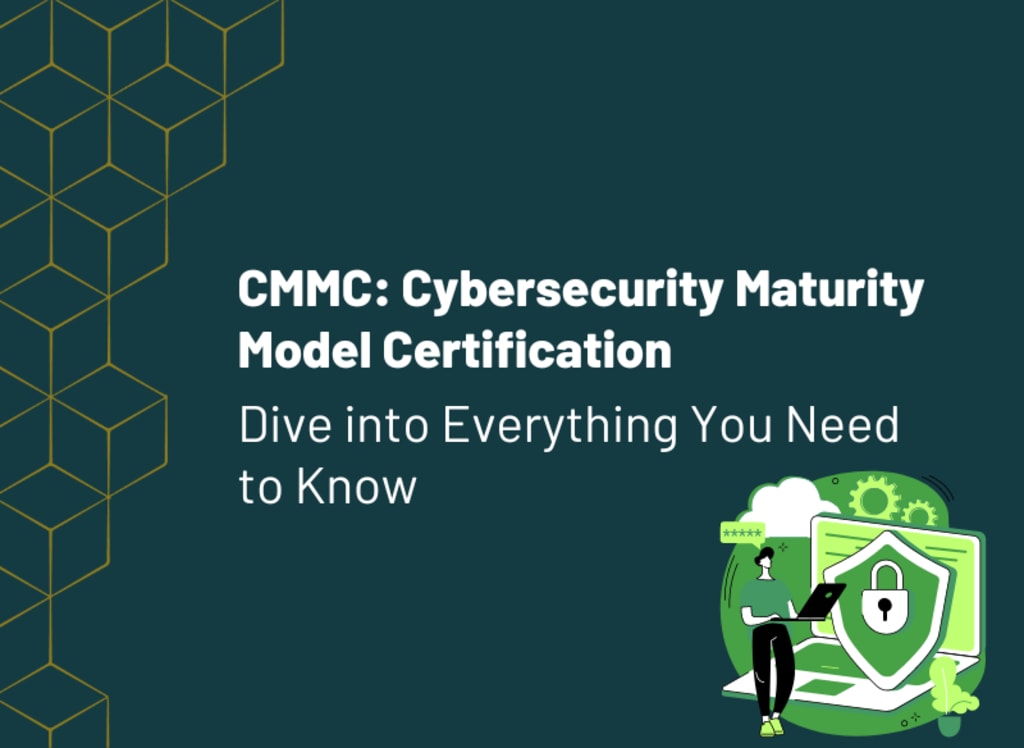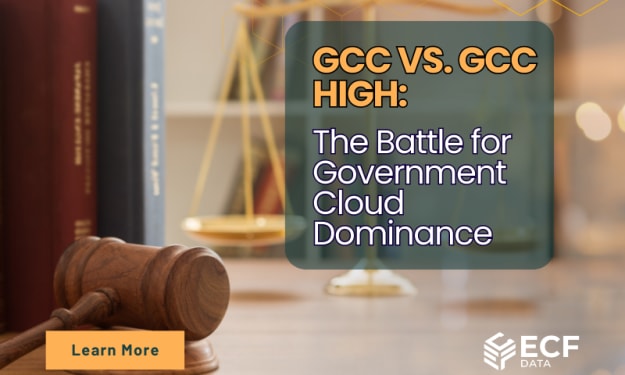Protect Your Business with CMMC Compliance: Essential Insights for Cybersecurity
Protect Your Business with CMMC Compliance

Cyber threats loom large and data breaches can have catastrophic consequences. Organizations across various industries are strengthening their efforts to fortify their cybersecurity defenses. One of the significant initiatives gaining traction in the United States is the Cybersecurity Maturity Model Certification (CMMC).
In this blog post, we will dive deep into everything you need to know about CMMC, from its purpose and fundamental objectives to the certification levels and assessment process. Whether you’re an individual looking to understand the fundamentals of CMMC or a business seeking to comply with its requirements, this guide will provide valuable insights and practical knowledge.
LEARN MORE ABOUT CMMC COMPLIANCE
What is CMMC?
CMMC is an initiative the United States Department of Defense (DoD) introduced to evaluate their defense contractors’ cybersecurity capabilities, preparedness, and sophistication. Essentially, this framework consists of a combination of processes, existing cybersecurity standards like NIST, FAR, and DFARS, as well as other relevant frameworks.
At a practical level, the main objective of the certification is to enhance the assurance and security of Controlled Unclassified Information (CUI) and Federal Contract Information (FCI) held and utilized by federal contractors. Since September 2020, the Department of Defense (DoD) has started including specific CMMC requirements in a limited number of requests for information. It is anticipated that CMMC will become a mandatory requirement for all new DoD requests for proposals starting in 2026.
What is the importance of CMMC?
The Cybersecurity Maturity Model Certification (CMMC) enhances cyber protection standards for all DoD contractors. CMMC model 2.0, the latest version, safeguards Controlled Unclassified Information (CUI) and Federal Contract Information (FCI). It replaces NIST 800-171 and DFARS clauses, gradually becoming a requirement for DoD contracts, with potential adoption by other US Federal Agencies. Over 300,000 contractors are expected to maintain CMMC Certification.
The objectives of CMMC include:
• Enhance Defense Industrial Base cybersecurity against evolving threats
• Encourage a collaborative culture for cybersecurity and resilience
• Protect sensitive information to support and safeguard the well-being of warfighters
• Enable accountability and streamline compliance with DoD requirements
• Uphold high professional and ethical standards to maintain public trust
Understanding the CMMC 2.0 Model
The three levels of CMMC 2.0 include:
• LEVEL 1: Foundational
• LEVEL 2: Advanced
• LEVEL 3: Expert
CMMC Level 1 involves 17 standards and an annual self-assessment, which most Microsoft cloud services can facilitate. Level 3, with over 110 practices based on NIST SP 800-172, mandates a triennial government-led assessment. Level 3 certification is anticipated for fewer than 200 companies, potentially necessitating provisions beyond GCC High. However, CMMC Level 2, the advanced level, demands meticulous planning and decision-making.
CMMC 2.0 Level 2 is aligned with NIST SP 800-171 practices and typically involves a triennial third-party assessment by a C3PAO. Government contractors must handle Controlled Unclassified Information (CUI). While there is speculation that a self-assessment process may be available for contracts involving less critical CUI, the final rules from the federal government will provide clarity. As a precaution, it is advisable to anticipate that CMMC Level 2 will require a third-party assessment.
Get Assistance with CMMC Certification
GCC High for CMMC Certification
DoD contractors seeking compliance with DFARS and preparing for CMMC may question the necessity of Microsoft’s Government Community Cloud (GCC) offerings for updating their IT infrastructure.
The most straightforward answer to that is: No. Private sector DoD contractors are not obligated to utilize Microsoft GCC or GCC High for DFARS, CMMC, or ITAR compliance. While alternative solutions that fulfill several NIST 800-171 requirements are available, Microsoft GCC or GCC High is often the most suitable choice.
Here are the advantages of using GCC/GCC High for a DoD contractor:
• Most businesses use Microsoft 365
Given the widespread adoption of Microsoft 365 among businesses in the United States, it is logical for them to opt for GCC and GCC High. By doing so, they can leverage familiar tools while ensuring compliance with NIST 800-171 through an infrastructure that meets the requirements.
• M365 offers a comprehensive, all-in-one solution
By serving as an all-in-one office solution that satisfies numerous NIST 800-171 requirements, it eliminates the necessity for companies to piece together multiple office solutions to achieve compliance. This streamlined approach can reduce costs associated with managing various tools and services.
• GCC/GCC High fulfills the requirements outlined in NIST 800-171
Transitioning to GCC (Government Community Cloud) can result in full or partial compliance with around 75% of the NIST 800-171 controls.
• Customer, whether it is the DoD or a Prime contractor, utilizes GCC/GCC High.
Contractors often discover that their customers already utilize GCC/GCC High, making it more convenient to exchange sensitive information and collaborate effectively on the same platform.
• GCC High is compliant with ITAR (International Traffic in Arms Regulations)
Transitioning to GCC High can result in full or partial compliance with approximately 75% of the NIST 800-171 controls and fulfill all the ITAR requirements.
Who can benefit from GCC High?
Microsoft GCC High is essential if you handle the following types of information:
• Export-controlled CUI
• Export Administration Regulations (EAR)
• Internation Traffic-in-Arms Regulations (ITAR)
• Specified CUI needing US Sovereignty, such as Controlled Defense Information (CDI), Controlled Technician Information (CTI), Nuclear Information (NERC/FERC), and Controlled Unclassified Information marked NOFORN.
While you can refer to the comprehensive list for specific details, it is essential to note that the information above always necessitates special treatment using Microsoft GCC High. Furthermore, operating within a sovereign cloud environment like Microsoft GCC High is essential for CMMC 2.0 levels 2 and 3, which aim to protect Controlled Unclassified Information (CUI).
Road to CMMC Compliance with ECF Data
Achieving CMMC compliance can be overwhelming, demanding, and intricate, but it is crucial. The most straightforward approach to attain genuine CMMC compliance is by collaborating with a reliable partner.
Partnering with a trusted CMMC partner like ECF Data offers multiple benefits, including meeting compliance requirements and minimizing business disruptions. Such a partner can assist you in evaluating your unique needs, creating and executing compliance strategies, and providing continuous support.
• ECF Data is a Microsoft Agreement for Online Services – Government (AOS-G) partner
• We have over 13 years of industry expertise and a proven track record of working extensively within the government sector.
• We are an authorized Microsoft partner offering Azure Government and GCC High licensing, migrations, and managed support to government entities, including Federal, Local, and State Governments, as well as DoD Contractors and supporting agencies.
We invite you to schedule a free discovery consultation with us. This session gives you the opportunity to learn more about your company, address any inquiries, and help you assess whether ECF Data is the ideal fit for your needs.
BOOK A DISCOVERY CALL
About the Creator
Joseph Henderson
ECF is a premier IT service and staffing provider in the US, we work with Organizations to deliver integrated IT solutions built on Microsoft technologies since its founding in 2010.
Enjoyed the story? Support the Creator.
Subscribe for free to receive all their stories in your feed. You could also pledge your support or give them a one-off tip, letting them know you appreciate their work.






Comments
There are no comments for this story
Be the first to respond and start the conversation.